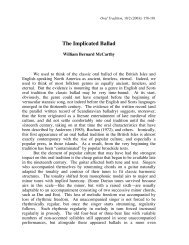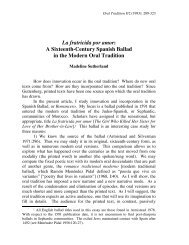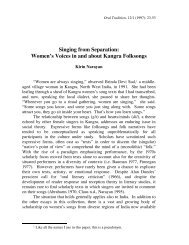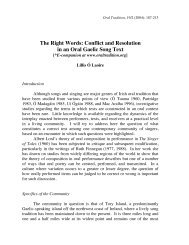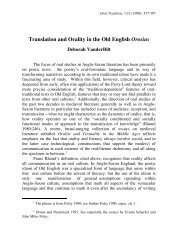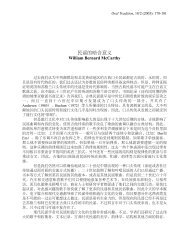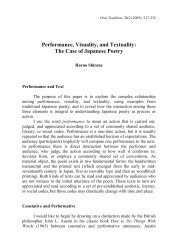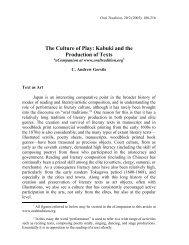Garner and Miller - Oral Tradition Journal
Garner and Miller - Oral Tradition Journal
Garner and Miller - Oral Tradition Journal
You also want an ePaper? Increase the reach of your titles
YUMPU automatically turns print PDFs into web optimized ePapers that Google loves.
366 LORI GARNER AND KAYLA MILLER<br />
over half of the colony flies out with the old queen, leaving the new queen <strong>and</strong> the remainder of<br />
the colony behind. Initially, they typically swarm briefly, settling in a tightly compacted ball only<br />
a few feet away. After bee “scouts” locate a more ideal location for the hive, the entire colony<br />
moves. The goal of the beekeeper is to encourage the bees to settle in the site of the beekeeper’s<br />
choice. The moments during <strong>and</strong> following the swarm are crucial since “as soon as they reach it<br />
[the location chosen by the scouts] they own it <strong>and</strong> they will defend it” (Underhill 2010a). Even<br />
though the sight of hundreds of swarming bees, which Underhill likens to the motion of a<br />
tornado, might be terrifying to surprised observers, the bees are actually at their least aggressive<br />
during <strong>and</strong> immediately following the swarm. In her brief but insightful discussion of parallels<br />
between Anglo-Saxon <strong>and</strong> modern beekeeping, Osborn recounts witnessing her father “move a<br />
swarm in his bare h<strong>and</strong>s <strong>and</strong> settle it in another hive” (2006:281). If the swarm occurs early<br />
enough in the season, the beekeeper’s goal is to capture the swarm so as to have two productive<br />
colonies. If the swarm is too late in the year, or if the beekeeper does not have ample space to<br />
maintain the new colony, an entire year’s work can be lost.<br />
With such high stakes, it seems likely that the poetic <strong>and</strong> cryptic remedy written in the<br />
margin does convey practical value, even at the same time that it serves other ritual, social, or<br />
psychological functions for the beekeeper or larger community. As Osborn astutely observes,<br />
“like many a practice that may be perceived as magic even by the practitioner, this traditional<br />
gesture has a practical value as well” (2006:280). While throwing dirt over the swarm serves a<br />
clear ritual function <strong>and</strong> “binds the bees with sympathetic magic to the beekeeper who has just<br />
thrown dirt over his head” (Osborn 2006:280), the action can also be very effective in inhibiting<br />
flight, thus encouraging the swarm of bees to settle nearby, in a location more easily accessible to<br />
the beekeeper, rather than departing entirely from the beekeeper’s domain.<br />
The extent of the ritual’s practical value, however, is determined in large part by how one<br />
renders “greot,” which the Dictionary of Old English defines as “grit, gravel, s<strong>and</strong>, shingle (of<br />
the seashore); dirt, dust” (DOE, s.v. “greot”). Gordon translates as “gravel” (1926:88) as does<br />
Grendon (1909:169). Osborn translates as “dirt” (2006:279). Kevin Crossley-Holl<strong>and</strong> (1999:271)<br />
<strong>and</strong> Marie Nelson (1984:58) both translate as “earth,” emphasizing the parallel between greot<br />
<strong>and</strong> eorð in the original, <strong>and</strong>, more recently, David Barber renders greot as “s<strong>and</strong>” (2011:489).<br />
While all are, from a safe academic distance, equally viable renderings of “greot,” from the<br />
perspective of a creature as small as a honeybee, the difference is one of utmost significance. For<br />
Crimmins, the logic of covering the swarm with light dust makes perfect sense:<br />
I know when we catch them in a swarm, to keep them from flying away when we put them in the<br />
box—it’s not dirt—but we will spray them with sugar water, <strong>and</strong> it somewhat seals the wings, you<br />
know, makes it sticky. They’ll eat it off, or clean each other off, <strong>and</strong> get it as food. But when you<br />
catch a swarm on a tree branch, you’ll pop it into the hive <strong>and</strong> you’ll spray it with the sugar water<br />
first. Perhaps, the dust . . . does the same, in that they cannot fly. Because I’m assuming that what<br />
they’re talking about with the swarm is putting something—dust or dirt, earth—over it, dusting it,<br />
coating it <strong>and</strong> not throwing clods of dirt at it, you know, but fine dust particles <strong>and</strong> keeping them<br />
from being able to fly so that when you put them in the beehive—or bee skep back when, [or] in a<br />
hollow log—they will settle in, <strong>and</strong> then they would call it home. . . . So that might be the<br />
principle behind dust or earth, . . . anything just to keep them from moving.



